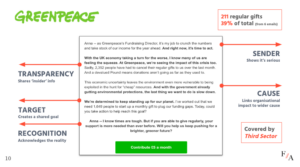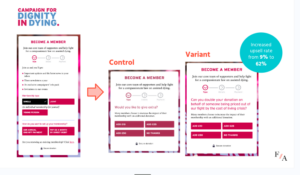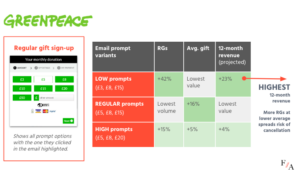In times of crisis, it’s undeniable that the work of charities becomes more crucial than ever, from campaigning for change to delivering essential services. The cost of living crisis has proved this more than ever.
But, with many supporters struggling to make ends meet, online fundraising to match increasing demand can feel like an impossible task.
At Forward Action, we know constant testing and optimisation is the key to success. Through our work with partners, we’ve been testing tactics designed to tackle the cost of living crisis head on, and have established four that resulted in significantly better results!
In our April webinar (watch the recording here), our Strategy Director Helen Hector shared these top four tactics and how you can start testing them in your own digital fundraising programmes.
1.Be open about the impact of the crisis on your organisation
Don’t be afraid to be honest with your supporters.
We’ve found that sharing real data about the impact of the crisis on your organisation can bring supporters closer to your movement.
We know it can feel unusual to talk about your organisation, rather than your cause, but our tests have proved this can be an effective way to make people feel like a part of the team, in turn motivating them to give. Just make sure once they’re hooked in, you pivot back to your cause and show what their support means to the mission.
Include specific and authentic data, and if possible, have a relevant senior member of the team, such as the finance director, be the sender of their emails. This creates a greater sense of gravitas that will make your supporters feel like they’re an insider.
Whilst your being honest, it won’t hurt to recognise the reality that your supporters may be struggling too. Set a target for what you want to raise and let your supporter know that any help they can offer in reaching that target is invaluable.

2. Invite people to pay it forward
Whilst not everyone is in a position to give, some of your supporters will be – and they may be keen to pay it forward.
When it comes to asking supporters to make a donation on behalf of those who can’t, testing is key because our results paint a nuanced picture.
Generally, warm supporters are keen to pay it forward, whereas colder supporters are less inclined to top up their donations on behalf of others. So it’s important you test first to find what works for your organisation.
Where it does work, there is potential for great success. Our partner Dignity in Dying found that tailoring their upsell messaging to ask supporters if they could ‘donate on behalf of someone who is being priced out of the fight’, saw their upsell rate skyrocket from 9% to 62%.

3. Ask for less, raise more
With the cost of living crisis hitting everyone, people may be looking for ways to engage with your organisation on a tighter budget. We’ve found that offering your audience lower donation prompts can not only bring in more donors, but more income overall.
Where we’ve tested this, we’ve unsurprisingly seen a drop in average gifts, but ultimately the increase in the volume of donations has offset this drop and led to an increase in overall income generated.
For Greenpeace, we tested three email variants, one with our standard buttons, one with higher prompts and finally a variant with lower prompts. The variant with the lower prompt saw 42% more people signing up, and led to 23% more income!
To make the most out of this tactic, try testing a regular gift upsell after your low cash ask.

4. Cost of living petitions drive signers, but not donations
Our final tip is around petitions – and when to use them. So much of our fundraising happens through acquisition funnels – we work with our partners to bring people into their organisations using handraisers or a petition, and then we ask them to donate.
Extensive testing has proved that topical handraisers or petitions are most successful to build engaged lists, and so the cost of living crisis has been a common theme in the past six months.
But while these are great at generating sign ups, these new supporters are often far less likely to immediately donate.
For example, Good Law Project saw a lower cost per lead on a cost of living themed handraiser compared to one on water pollution. But this was flipped when it came to regular giving:

Ultimately, if you’re looking to bring people into your organisation, a cost of living handraiser could do the trick, but if your overall goal is to raise donations – this tactic may not be the best place to start.
We hope you’ve enjoyed our webinar run down. Want to join our next webinar? Get our emails.
We know you must have some burning questions, here are some we talked through in the webinar:
Q: We often talk about the cost of living and how it impacts our beneficiaries, but not the organisation itself. Do you think one is more powerful than the other?
Talking about beneficiaries can feel like the more intuitive and compelling story to tell, and we know it works so we’re not suggesting you stop building this narrative into your supporter communications. But talking about the impact on your organisation alongside that also has potential to mobilise your supporters into action.
Staying authentic by using genuine data and having the email be sent from a relevant member of your team will help you make it work with your brand as an organisation.
Make sure to pivot away from the impact of the COL on your organisation, to the impact on your beneficiaries or cause and you’ll be set up for success.
Q. When it comes to paying it forward, do you have any info on testing that messaging with a cold audience?
We tested this messaging in a few places by introducing it at the point of sign up, but found no overall significant results.
In our experience this works best when you’re dealing with warm audiences that are already keen to take action.
Q. What trends have you seen around the ‘x number of people are cancelling their Direct Debits’ messaging. Does it work really well a couple of times initially and then tail off, or is it consistently effective?
So far, our partners have only tested this tactic once in one email journey, so we don’t have results for how well this would fare if repeated.
However, if you focus this hook around a particular crisis moment, and make sure to include a goal or target, you’ll have the opportunity to send follow up emails detailing data on how many people signed up as a result of the first email.
This is great if you’re looking to build momentum around a particular target.
Q. In regards to handraisers were the cost per regular giver results from telemarketing call or just an email journey?
All the examples we discussed in April’s webinar were a result of email journeys at the point of signup, rather than telemarketing calls. However, some of our partners do use telemarketing as a way to bring supporters into their organisation. Check out our February webinar with Stonewall’s Head of Individual Giving, Jake O’Dwyer to hear some of their key insights.
Q.What are your expectations as to whether the cost of living framing will decrease in effectiveness over the summer? Bills tend to be higher in winter, therefore greater impact on donors. Should we wait until next winter to begin testing this messaging again?
This is a great question. We have found that the cost of recruiting new subscribers has become much lower over the summer months. We tend to see a bit of a lull at the height of summer, so those running acquisition programmes during this time often see lower cost per lead.
So while It feels logical that cost of living framing will be less effective in summer as energy bills go down and the pressure of Christmas lifts up, we still think it’s a valuable window to run paid social fundraising campaigns and the results might surprise you.
Our advice is to keep an eye on what’s happening in the real world and reflect this back to your supporters.
There’s always an angle that you can use to bring your cause to front of people’s lives.

